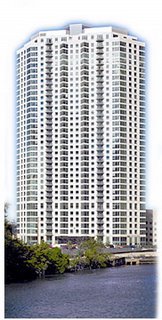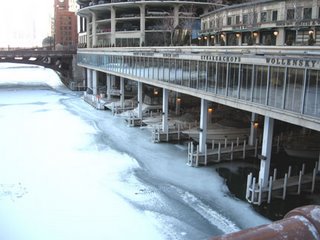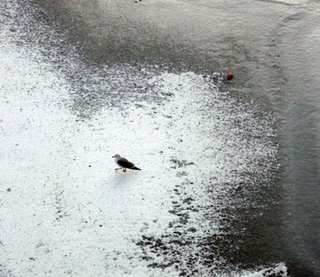Chicago's Two Track Building Boom - Tribune architecture critic Blair Kamin explores how a monopolization of attention by high profile projects like Santiago Calatrava's Chicago Spire is overshadowing the far larger number of clunky
 new buildings that are littering the city. For every elegant solution, from Laurence Booth's 30 West Oak (pictured), or Miller/Hull's 156 West Superior, there's at least as many skyline-scarring clunkers like DeStefano + Partners Left Bank at Kinzie Station
new buildings that are littering the city. For every elegant solution, from Laurence Booth's 30 West Oak (pictured), or Miller/Hull's 156 West Superior, there's at least as many skyline-scarring clunkers like DeStefano + Partners Left Bank at Kinzie Station  , which evokes less the sidewalks of Paris than a kind of architectural K-ration. It's possible that over the decades we'll come to accept, if not actually love, these kind of lazy build, flip, and repeat developments at which Fifield is a master, but it's more likely that the only thing they're accomplishing is lowering the standard of mediocrity. Ultimately, they're parasitic - bringing people back to city and its neighborhoods at the same time as they eat away at the character that makes them attractive places to live in the first place. Read it here.
, which evokes less the sidewalks of Paris than a kind of architectural K-ration. It's possible that over the decades we'll come to accept, if not actually love, these kind of lazy build, flip, and repeat developments at which Fifield is a master, but it's more likely that the only thing they're accomplishing is lowering the standard of mediocrity. Ultimately, they're parasitic - bringing people back to city and its neighborhoods at the same time as they eat away at the character that makes them attractive places to live in the first place. Read it here.Winter - It Will Actually End? - With subzero
 cold leaving the Chicago River covered in ice in the first time in years, and our East coast compatriots buried in up to ten feet of snow, it's
cold leaving the Chicago River covered in ice in the first time in years, and our East coast compatriots buried in up to ten feet of snow, it's  enough to make you momentarily doubt global warming, or even wonder if Spring will ever come. A hopeful answer came this week, not from a groundhog, but from the Sunday New York Times, which is carrying a full page ad announcing this summer's schedule for the Tanglewood Festival, for which tickets go on sale today. Ravinia's former long-time Music Director James Levine will lead performances of The Damnation of Faust, Bluebeard's Castle, and the full, four-act version of Don Carlos with Patricia Racette, Johan Botha and Samuel Ramey, as well as a sequence of fully-staged performances of Cosi Fan Tutte. It tends to be a little pricey, though - top tickets going for just a buck less than $100.00, versus a typical $50.00
enough to make you momentarily doubt global warming, or even wonder if Spring will ever come. A hopeful answer came this week, not from a groundhog, but from the Sunday New York Times, which is carrying a full page ad announcing this summer's schedule for the Tanglewood Festival, for which tickets go on sale today. Ravinia's former long-time Music Director James Levine will lead performances of The Damnation of Faust, Bluebeard's Castle, and the full, four-act version of Don Carlos with Patricia Racette, Johan Botha and Samuel Ramey, as well as a sequence of fully-staged performances of Cosi Fan Tutte. It tends to be a little pricey, though - top tickets going for just a buck less than $100.00, versus a typical $50.00  top at last year at Ravinia, although Tanglewood wins out for the lowest priced seats - $18.00 versus Ravinia's $20.00. See the full schedule here.
top at last year at Ravinia, although Tanglewood wins out for the lowest priced seats - $18.00 versus Ravinia's $20.00. See the full schedule here.CSO Still Top Ten - Meanwhile, Financial Times Music Critic Andrew Clark writes how, despite an increasing roster of quality orchestras worldwide, the list of the best of the best is pretty much the same as it was fifty - or even a hundred - years ago. According to Clark, while an exceptionally inspiring conductor like Mariss Jansons or Simon Rattle can make an ensemble like the Oslo Philharmonic or City of Birmingham Symphony appear world class, the quality of play seldom endures after their departure, and we're left with the usual suspects, which in America means the inevitable "Top Five" - New York, Chicago, Philadelphia, Cleveland and Boston. In Clark's own current global top ten, James Levine's Met Orchestra replaces Maazel's New York Philharmonic, Eschenbach's troubled Philadelphia doesn't make the cut, and the Chicago Symphony is grudgingly included, despite its "over-dominant brass" making it the embodiment of "pure American beefcake," which is pretty funny, when you consider that it's largely the product of two Hungarians named Reiner and Solti. Read it here.
3 comments:
Kind of odd that he mentions 30 W Oak (which is a fine building) when that project resulted in the destruction of the Scholl’s School.
I was unmoved by Kamin's critique. Mediocre buildings are a part of the city-any city, including Chicago of the past (surely no one thinks that every pre-war building was a masterpiece). What was puzzling was his conclusion, which lauded the Pappageorge project on Roosevelt, while acknowledging it was not great architecture, on the grounds it more or less fit in with the wall of buildings around it.
Huh? What does it accomplish that the Left Bank doesn't? My take-away was that Blair likes glass, not concrete.
If we're in the business of promoting city-friendly design, we can restrict our interventions or prescriptions to something simple like David Sucher's three rules. If we're about skyline-friendly design, I think something similarly simple will suffice, such as reductions in floorplates for every additional x stories, reducing the "bland vanilla box" effect while allowing designers freedom of materials. But I do think it is incumbent upon critics like Kamin to suggest improvements rather than the meaningless practice of pointing to buildings they like and criticizing those they don't.
If you are interested in wine making then you need to do a little homework before you get started. Wine making is not something that you can just plunge into and learn along the way, you need to do some research so that you know that you are not missing any vital wine making steps or processes. If you do miss these wine making your wine could very well turn out tasting like anything but wine.
Wine making is a something fun that you can do in your spare time and at the end you will have a glorious result. Wine making is something that people tend to get hooked on because the very first batch is not usually perfect, it may taste delicious but it will not be perfect. As you learn about wine making and as you get the wine making experience behind you your wine will get better and better. You will undoubtedly pick up tips and tricks to help you improve your wine making capabilities.
Post a Comment